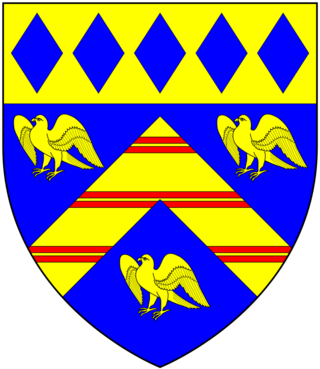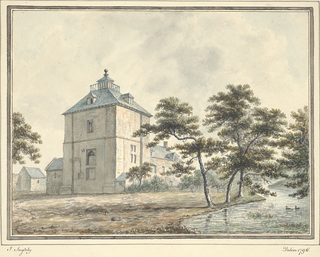
Earl of Scarbrough is a title in the Peerage of England. It was created in 1690 for Richard Lumley, 2nd Viscount Lumley. He is best remembered as one of the Immortal Seven who invited William of Orange to invade England and depose his father-in-law James II. Lumley had already been created Baron Lumley, of Lumley Castle in the County of Durham, in 1681, and Viscount Lumley, of Lumley Castle in the County of Durham, in 1689. These titles are also in the Peerage of England. The title of Viscount Lumley, of Waterford, was created in the Peerage of Ireland in 1628 for his grandfather Sir Richard Lumley, who later fought as a Royalist in the Civil War.

Earl of Macclesfield is a title that has been created twice. The first creation came in the Peerage of England in 1679 in favour of the soldier and politician Charles Gerard, 1st Baron Gerard. He had already been created Baron Gerard, of Brandon in the County of Suffolk, in 1645, and was made Viscount Brandon, of Brandon in the County of Suffolk, at the same time as he was given the earldom. These titles are also in the Peerage of England. Lord Macclesfield was the great-grandson of the distinguished judge Sir Gilbert Gerard, Master of the Rolls from 1581 to 1594. He was succeeded by his eldest son, the second Earl. He was involved in the Rye House Plot of 1683, was sentenced to death but later pardoned by the King. On his death without legitimate issue in 1701 the titles passed to his younger brother, the third Earl. He had earlier represented Yarmouth, Lancaster and Lancashire in the House of Commons. When he died in 1702 the titles became extinct.

Earl of Lonsdale is a title that has been created twice in British history, firstly in the Peerage of Great Britain in 1784, and then in the Peerage of the United Kingdom in 1807, both times for members of the Lowther family.

Earl of Rosse is a title that has been created twice in the Peerage of Ireland, both times for the Parsons family. "Rosse" refers to New Ross in County Wexford.

Viscount Hawarden is a title in the Peerage of Ireland.

Baron Muskerry is a title in the Peerage of Ireland. It was created in 1781 for Sir Robert Deane, 6th Baronet. He had previously represented County Cork in the Irish House of Commons.

Baron Croft, of Bournemouth in the County of Southampton, is a title in the Peerage of the United Kingdom. It was created on 28 May 1940 for the Conservative politician Sir Henry Page Croft, 1st Baronet. He had already been created a baronet of Knole in the Borough of Bournemouth in the County of Southampton in the Baronetage of the United Kingdom on 28 February 1924. Croft was the grandson of Reverend Richard Croft, third son of Dr. Sir Richard Croft, 6th Baronet, of Croft Castle. As of 2010 the titles are held by the first Baron's grandson, the third Baron, who succeeded his father in 1997.

Baron Rea, of Eskdale in the County of Cumberland, is a title in the Peerage of the United Kingdom. It was created in 1937 for the businessman and Liberal politician Sir Walter Rea, 1st Baronet, who had earlier represented Scarborough, Bradford North and Dewsbury in the House of Commons. He had already been created a Baronet, of Eskdale in the County of Cumberland, in 1935. He was succeeded by his eldest son, the second Baron. During the Second World War he served as personal staff officer to Brigadier Colin Gubbins, the Head of SOE, a key British intelligence and guerrilla operations agency. Lord Rea served as Leader of the Liberal Party in the House of Lords from 1955 to 1967. His daughter, the Right Hon. Ann Felicity Rea, married SOE veteran Malcolm Munthe in 1945. His nephew, the third Baron, who succeeded in 1981, was a physician. He was one of the ninety elected hereditary peers elected to remain in the House of Lords after the passing of the House of Lords Act 1999, and sat on the Labour benches. As of 2020 the titles are held by his son, the fourth Baron, who succeeded his father in that year.

Baron Roborough, of Maristow in the County of Devon, is a title in the Peerage of the United Kingdom. It was created on 24 January 1938 for Sir Henry Lopes, 4th Baronet. He had earlier represented Grantham, Lincolnshire, in Parliament as a Conservative. The Baronetcy, of Maristow House in the County of Devon, had been created in the Baronetage of the United Kingdom on 1 November 1805 for Manasseh Masseh Lopes, a member of a wealthy family of Portuguese Jewish origin, with special remainder to his nephew Ralph Franco, son of his sister Maria. Manasseh Masseh Lopes converted to Christianity in 1802, and later represented Evesham, in Worcestershire, Barnstaple in Devon, and Westbury in Somerset, in Parliament. However, in 1819 he was twice convicted of bribing the voters in both Barnstaple and Grampound in order to be elected to Parliament, and was sentenced to imprisonment and heavy fines. He was also unseated by the House of Commons, but after his release from prison he nonetheless got elected for Westbury, a pocket borough which he controlled to a great extent.

There have been seven baronetcies created for members of the Lowther family, one in the Baronetage of Nova Scotia, two in the Baronetage of England, two in the Baronetage of Great Britain and two in the Baronetage of the United Kingdom. Two of the creations are extant as of 2008.
Baron Renwick, of Coombe in the County of Surrey, is a title in the Peerage of the United Kingdom. It was created on 23 December 1964 for the businessman and public servant, Sir Robert Renwick, 2nd Baronet. He notably worked for the Air Ministry and the Ministry of Aircraft Production during the Second World War. The Renwick Baronetcy, of Coombe in the County of Surrey, was created in the Baronetage of the United Kingdom on 28 June 1927 for his father, Harry Renwick. As of 2020 the titles are held by the first Baron's grandson, the third Baron, who succeeded in that year. The second baron was active in the House of Lords until the House of Lords Act 1999, when he lost his seat in parliament.
There have been two baronetcies created for a person with the surname Clifford.
There have been three baronetcies created for members of the Shelley family, one in the Baronetage of England and two in the Baronetage of the United Kingdom. The three recipients of the titles represented two different branches of the family with a common ancestor in John Shelley of Michelgrove. The most famous member of the family is the poet Percy Bysshe Shelley, although he never held any title. The holders of the third and last creation were later elevated to the peerage as Baron De L'Isle and Dudley and Viscount De L'Isle.
There have been three baronetcies created for persons with the surname Bellingham, one in the Baronetage of England, one in the Baronetage of Ireland and one in the Baronetage of Great Britain. As of 2014 one creation is extant.
The Hoghton or Houghton, later Bold-Hoghton, later de Hoghton Baronetcy, of Hoghton Tower in the County of Lancashire, is a title in the Baronetage of England. It was created on 22 May 1611 for Richard Hoghton, Member of Parliament for Lancashire. The Hoghton family had been landowners in Lancashire since the reign of King Stephen and had been Knights of the Shire for Lancashire since the 14th century. The second Baronet represented Clitheroe and Lancashire in the House of Commons and was a Royalist leader during the Civil War. The third and fourth Baronets both sat as Members of Parliament for Lancashire. The fifth Baronet was Member of Parliament for Preston and East Looe while the sixth and seventh Baronets represented Preston. The eighth Baronet assumed the additional surname of Bold. In 1892 the ninth Baronet resumed, by Royal licence, the ancient family surname of de Hoghton.

The Sebright Baronetcy, of Besford in the County of Worcester, is a title in the Baronetage of England. It was created on 20 December 1626 for Edward Sebright, High Sheriff of Worcestershire who later fought as a Royalist in the Civil War. He was the son of John Sebright of Blakeshall, Wolverley and was the heir of his uncle William Sebright (1541–1620) of Besford, who established by his will in 1620 the charity "Sebright's Endowed Schools", still surviving today and very richly endowed as "Sebright's Educational Foundation". The fourth Baronet sat as Member of Parliament for Hertfordshire. The sixth Baronet represented Bath in the House of Commons. The seventh Baronet was Member of Parliament for Hertfordshire and also became known as an agriculturalist. The family's fortunes ebbed by the end of the nineteenth century, with the ninth Baronet leaving only £5 at his death. The current baronet is Sir Rufus Hugo Giles Sebright, born 1978 in Nîmes, France.

There have been two baronetcies created for persons with the surname Leighton, one in the Baronetage of England and one in the Baronetage of the United Kingdom. One creation is extant as of 2010.
Sir Philip Musgrave, 2nd Baronet was an English politician who sat in the House of Commons of England from 1640 to 1643 and from 1661 to 1678. He served in the Royalist army in the Civil War.
Sir Richard Musgrave, 3rd Baronet was an Irish baronet and politician.

Earl of Arran is a title in the Peerage of Ireland. It is not to be confused with the title Earl of Arran in the Peerage of Scotland. The two titles refer to different places: the Aran Islands in Ireland, and the Isle of Arran in Scotland. The Irish earldom is held by the Gore family. The Scottish earldom is a separate title, held as a subsidiary title of the Duke of Hamilton.










